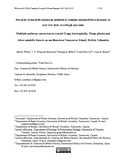Mostrar el registro sencillo del ítem
Multiple pathway succession in coastal Tsuga heterophylla, Thuja plicata and Abies amabilis forests on northeastern Vancouver Island, British Columbia
| dc.creator | Weber, Adrian | es_ES |
| dc.creator | Kimmins, J.P. (Hamish) | es_ES |
| dc.creator | Gilbert, Benjamin | es_ES |
| dc.creator | Lo, Yueh-Hsin | es_ES |
| dc.creator | Blanco Vaca, Juan Antonio | es_ES |
| dc.date.accessioned | 2015-12-30T10:24:53Z | |
| dc.date.available | 2015-12-30T10:24:53Z | |
| dc.date.issued | 2014 | |
| dc.identifier.issn | 0045-5067 (Print) | |
| dc.identifier.issn | 1208-6037 (Electronic) | |
| dc.identifier.uri | https://hdl.handle.net/2454/19816 | |
| dc.description.abstract | Sustainable forest practices are often designed to mimic natural disturbance and successional processes, yet succession is poorly understood in many ecosystems. On northeastern Vancouver Island, the ‘disturbance hypothesis’ is a widely-assumed succession model that asserts shade tolerant western redcedar (Thuja plicata) and the ericaceous shrub salal (Gaultheria shallon) invade and colonize highly productive western hemlock (Tsuga heterophylla) – Pacific silver fir (Abies amabilis) stands (HA) on zonal sites in the absence of stand-replacing wind disturbance. This leads to the development of low productivity, low density, uneven-aged, open-crowned redcedar-hemlock-salal stands (CH). In conflict with this model, old, apparently stable HA stands lacking redcedar can be found on such sites as well. We sought evidence for the predicted transition to CH stands by examining stand composition, crown closure, tree size class frequency distributions, salal cover, and redcedar establishment on young HA (~90 years old), old HA (>160 years), and CH (>160 years) stands. When adjacent to a redcedar stand, young HA stands had fewer redcedar seedlings but more redcedar adult trees than old HA stands. However, redcedar abundance did not differ between young and old HA stands at distances further than 10 m from adjacent redcedar stands. This could indicate that redcedar recruits into HA stands at stand establishment, and that redcedar seedling establishment is low under the thick canopy of young HA stands. The chronosequence data also suggest that both old HA and CH stands are self-replacing stand types in these forests, contrary to the disturbance hypothesis. We develop a new, multi-pathway model for this ecosystem that is based on the chronosequence data and life-history traits of the focal tree species, and suggest that disturbance plays a role opposite to the equilibrium model. | en |
| dc.format.mimetype | application/pdf | en |
| dc.language.iso | eng | en |
| dc.publisher | NRC Research Press | en |
| dc.relation.ispartof | Canadian Journal of Forest Research, 2014, 44(10): 1145-1155 | en |
| dc.rights | Creative Commons Attribution-NonCommercial-NoDerivatives 4.0 International (CC BY-NC-ND 4.0) | en |
| dc.rights.uri | https://creativecommons.org/licenses/by-nc-nd/4.0/ | |
| dc.subject | Forest succession | en |
| dc.subject | Multiple pathways | en |
| dc.subject | Mixed forests | en |
| dc.title | Multiple pathway succession in coastal Tsuga heterophylla, Thuja plicata and Abies amabilis forests on northeastern Vancouver Island, British Columbia | en |
| dc.type | Artículo / Artikulua | es |
| dc.type | info:eu-repo/semantics/article | en |
| dc.contributor.department | Ciencias del Medio Natural | es_ES |
| dc.contributor.department | Natura Ingurunearen Zientziak | eu |
| dc.rights.accessRights | Acceso abierto / Sarbide irekia | es |
| dc.rights.accessRights | info:eu-repo/semantics/openAccess | en |
| dc.identifier.doi | 10.1139/cjfr-2014-0060 | |
| dc.relation.publisherversion | https://dx.doi.org/10.1139/cjfr-2014-0060 | |
| dc.type.version | Versión aceptada / Onetsi den bertsioa | es |
| dc.type.version | info:eu-repo/semantics/acceptedVersion | en |



